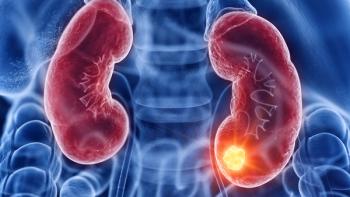
ctDNA Makes Headway as Promising Marker for Patients With Anal Cancer and Other GI Malignancies
Terri Pollack, DNP, APRN, FNP-C, PMHNP-BC, shares some of her top takeaways from the 2023 ASCO GI Cancers Symposium.
Emerging data with circulating tumor DNA (ctDNA) may hold the potential to optimize treatments for patients with anal cancer and other gastrointestinal cancers, according to Terri Pollack, DNP, APRN, FNP-C, PMHNP-BC.
“Great things are coming,” said Pollack, a nurse practitioner with the Gastrointestinal Cancer Site Disease Group in the Department of Medical Oncology at the University of Miami Sylvester Comprehensive Cancer Center, “Things can only get better. For me, the ctDNA piece was one of the most exciting things of the year.”
During the 2023 American Society of Clinical Oncology Gastrointestinal Cancers Symposium (ASCO GI), investigators showed that surveillance with ctDNA monitoring may be more effective than standard clinical measures in showing whether patients with anal squamous cell carcinoma (ASCC) are achieving responses with chemoradiation (CRT). This study assessed 31 patients with ASCC who were being treated with a median radiation dose of 54 Gy in 27 fractions along with chemotherapy. At baseline, 85% of patients had showed dectectable ctDNA.1
At a midtreatment analysis, 57% of patients cleared ctDNA—the median clearance time was 21 days. Moreover, 73% of patients with stage I/II disease (n = 11) reached treatment clearance of ctDNA at a median of 30 days and 50% of patients with stage III disease (n = 20) reached treatment clearance of ctDNA at a median of 31 days. Patients whose ctDNA was cleared midtreatment vs those who cleared posttreatment had significantly lower median ctDNA baseline values.
By the end of treatment, the rate of ctDNA clearance in the overall population was 96%. Three months postchemoradiation the complete clinical response rate was 96%. The 1-year locoregional recurrence rate was 4%, the 1 year disease-free survival rate was 96%, and the 1-year overall survival rate was 100%. The median time to ctDNA clearance was 30 days and the median time to clinical complete response was 136 days.
Investigators concluded that ctDNA is a useful response detection tool as it demonstrated an 85% detectability rate and ctDNA clearance preceded clinical complete response by approximately 100 days.
In an interview with Oncology Nursing News®, Pollack unpacked the significance of this data and shared some of her key takeaways from the conference, including interesting readouts from arms of the TAPUR trial (NCT02693535), which is a basket trial assessing FDA-approved agents for patients based on actionable genetic alterations, and how using Signatera assay to assess ctDNA in patients may translate to clinical practice.1-3
Oncology Nursing News®: What were some data to come out of the meeting that you found particularly interesting and did anything strike you as potentially practice changing?
Pollack: There were 2 things [that stood out to me]. The TAPUR trial [arm] that looked at olaparib [Lynparza] in individuals with colorectal cancer who had an ATM mutation or deletion. These were individuals who were heavily pretreated. This trial did not show any antitumor activity [with olaparib] in this population. In essence, [the trial] was negative. I found that data to be very interesting.1
Abstract 546, which also was part of the TAPUR [protocol, [assessed] pertuzumab [Perjeta] plus trastuzumab [Herceptin] in individuals with biliary tract cancers with ERBB2/3 amplifications, expressions, or mutations. This [trial] did show positive antitumor activity and these individuals were heavily pretreated. This is very good to know and could change practice—this is something that we could potentially use down the line.2
Some other things that came out of the meeting, that I found to be particularly interesting, were the discussions regarding the importance of ctDNA. This is a hot topic [as we] move forward with immunotherapy. There was also a great presentation on artificial intelligence.
[Also of note] were [the discussions on] equity and the mortality rates of minorities in the United States. There’s been a lot of talk lately [about] disparities in our nation and I think it’s a big part of what’s been going on in our nation besides medicine. It was nice to see that individuals brought up this topic up at ASCO GI.
Do you believe ctDNA might represent a valuable surveillance measure for patients who might not have as many resources?
There [is] promise for patients with anal cancer receiving chemoradiation, with the monitoring of ctDNA. Anal cancer is not discussed much, whether it’s an interview like this, or if you go to a promotional talk. There are not enough discussions on anal cancer. So, to see this come out and talk about the analysis of ctDNA [with an assay] that’s commercially available is [encouraging].3
This [trial used] Signatera. [investigators] looked at 31 patients, the median age was 61 [years], and [many of] these individuals had stage III disease [65%]. So again, this is something that that is [not] talked about enough. The patients had received radiation [a median of] 54 gy over 27 fraction [over] a median of 38 days. So that’s quite a bit of radiation, it’s essentially a month’s worth.. Those who received [combination] chemotherapy received mitomycin [plus 5-FU or] capecitabine plus mitomycin. [The other regimen] was capecitabine alone. None of these 3 are super easy regimens.
After 32 weeks follow-up, the baseline median ctDNA values were lower in patients who cleared ctDNA midtreatment compared with those who cleared it posttreatment. And that was assessed retrospectively. By the end of the treatment, the rate of ctDNA clearance in the overall population was 96%. A very nice number. I thought that was a nice [study] to read and discuss. It gives promise [for these patients].
What do you think are the implications of this research?
When you give a patient a great ctDNA result, the smile on their face is huge. I work primarily in pancreatic adenocarcinoma, and we don’t get a lot of smiles, but over the past [few] months that we’ve been [testing] ctDNA through outside organizations in our practice, we have got some really nice hits with low-low to 0 ctDNA. And for those individuals and their families who understand what we’ve explained about it, it’s really exciting. Again, we don’t get a lot of smiles, we don’t get a lot of excitement in our exam rooms. From the patient happiness perspective, I think it's fantastic.
From a clinical perspective, when we’re watching [a patient], let’s say on surveillance, we can use the data from ctDNA results to overshadow a scan [where] we might not have seen anything yet; or tumor marker that might not be bulging; or a tumor marker that’s just going up a little tiny bit, but we don’t see anything on the scan. ctDNA is just another tool in the toolbox. I feel like it’s maybe going to be like a power drill instead of a little screwdriver.
I remember back when, in-house, we couldn’t get KRAS testing to see if [an individual] was wild-type or not, to know if we should use bevacizumab or [cetuximab] Erbitux. Then within in a short amount of time, it was in-house, and it was covered by insurance. Then when we first had NGS [next-generation sequencing], it was so expensive. Then it became everyday practice.
So now [there is] ctDNA [monitoring], and if I was to go back maybe 20 months in our particular practice, we were not using it yet. The colorectal team, right next to us was, was using it and they [told us], ‘You should try this.’ So, I am very pumped up that there’s something new.
References
- Alvarez J, Cercek A, Mohan N, et al. Circulating tumor DNA (ctDNA) for response assessment in patients with anal cancer treated with definitive chemoradiation. J Clin Oncol. 2023;41(suppl 4):1. doi:10.1200/JCO.2023.41.4_suppl.1
- Behl D, Rothe M, Mangat, PK, et al. Olaparib (O) in patients (pts) with colorectal cancer (CRC) with ATM mutation (mut): results from the targeted agent and profiling utilization registry (TAPUR) study. J Clin Oncol. 2023;41(suppl 4):122. doi:10.1200/JCO.2023.41.4_suppl.122
- Cannon TL, Rothe M, Garrett-Mayer E, et al. Pertuzumab plus trastuzumab (P+T) in patients (pts) with biliary tract cancer (BTC) with ERBB2/3 amplification (amp), overexpression (oe), or mutation (mut): results from the targeted agent and profiling utilization registry (TAPUR) study. J Clin Oncol. 2023;41(suppl 4):546. doi:10.1200/JCO.2023.41.4_suppl.546
Newsletter
Knowledge is power. Don’t miss the most recent breakthroughs in cancer care.
























































































